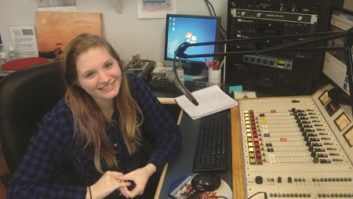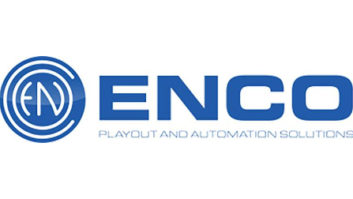This is the third in a series about creation of low-power radio station WHCP in Cambridge, Md. Mike Starling is general manager and chief engineer. Read the earlier parts atradioworld.com/whcp1and /whcp2.

The author, with scissors, cuts the ribbon in June. The station will inaugurate service on July 4. If we are lucky, a few times in our life we get to collaborate on projects of significance where teamwork, strategy and happenstance fall into place beautifully.
WHCP’s story is one of those, largely a result of good fortune and great timing. The article we wrote last August in Radio World coincided with the start of a drumbeat of equipment donations that have made all the difference. And our Cambridge Community Radio Calendar — our first public appearance in the local community — sold well, raised awareness and set the tone for being a classy, positive and thoughtful contributor to our fair city.
The end-of-year calendar raised a few thousand dollars towards construction, but we needed three times that amount to commence operations (the non-climate controlled barn without plumbing wasn’t going to do, nor was the short mast near the barn).
We needed some serious fundraising. And that’s when our board members stepped up and said “Let’s do an early spring fundraiser with a DJ, silent auction, raffle tickets, wine pull and other activities to raise funds.” They didn’t just talk about it; they did it. We received more than 30 donations from artists, pilots, property owners and businesses donating goods and services for the auction. We primarily advertised on Facebook and quickly sold out the ballroom at the Cambridge Yacht Club.
It was a brutal winter, but the weather broke coinciding with our Saturday, March 21, fundraiser. A great time was had by all; we exceeded our ambitious fundraising goal by 30 percent and were quickly zeroing in on final purchases.

The crew from Eastcor hangs the Shively antenna. Walt Myers leans out, John Yanik is at right.FINDING STUDIOS
Initially, we found a promising former doctor’s office a half-block from downtown, including an upstairs apartment. This looked too good to be true as the mortgage payment could be fully offset by the upstairs rental income. It seemed perfect … until we discovered the pipes in the radiator heating system had not been winterized. One radiator had exploded and the rest of the system, including the $10,000 boiler, was in dubious condition. We simply couldn’t take on that decided risk.
So we looked downtown for vacant retail space — and settled on a small retail shop of about 800 square feet with one large front room facing the most active block in downtown; this would become Studio A. The other rooms would serve as Studio B; a shared office space accommodating four workstations; and an oversized brick furnace room that room became the “Engineering Room.” We added a small rack to the shared office area where the venerable QEI Mod Monitor and EAS equipment lives and used 12-pair Belden tying the studios, office and engineering room together using donated Krone blocks.
THE CASE OF THE MISSING TOWER
We knew that with only 100 watts ERP, indoor penetration — especially for the “MidShore Radio Reading Service” on 67 kHz SCA — would require a “close in” look angle to the community. We settled in at 120 feet HAAT on the City Municipal Tower, minimizing the ERP derating. It even had a big generator just outside the tower fence. We struck a deal with the city and assumed the FCC 318 modification would be quick and easy.
But … there was no apparent Antenna Structure Registration for the tower. We discovered that the ASR had been filed erroneously for a kilometer away. To correct that we had to achieve clearance through the FAA, as the tower fails the TOWAIR calculation by 10 feet. To compound the error, we couldn’t amend the original ASR because the FCC had never been notified it had actually been constructed when built in 1978.
Once again — just as with the low-power desk at the FCC and the FAA Eastern Region tower experts — it only took a helpful conversation with the WTB folks in Gettysburg, Pa., who tutored us about how to notify them the tower was actually constructed at the amended coordinates. Voilà, we could now file the Form 318 minor change modification specifying the new tower location, and moving down one channel to 101.5 FM to avoid interference from a planned move by the nearby station on 101.7. This took only three months to sort out!
Ultimately that application, like all of our others, was processed in rapid order; we needed only the antenna and a tower rigger to get the job done.

WHCP is fired up.WHEN BAD NEWS TURNS GOOD
By April our remaining major purchases were only four: the transmitting antenna, tower rigger, transmission line and the CAP-compliant EAS receiver.
We had received a number of emails and private messages from well wishers offering support, and one in particular arrived from the head of a local engineering services company offering “computers and other technology assistance.” I suggested a coffee and thanked them for the offer of some gently used computers and indicated how this would offset the quote from the recommended tower rigger in our area of $2,000 vs. the $500 I had naively budgeted. To which the president of Eastcor replied “Oh, you need a tower rigger? You know, we have some that work for our company, we can probably help with that.” To which we exclaimed, “How terrific, that only leaves the purchase of the antenna as our last major item.” A short pause ensued followed by “Actually, we also have a machine shop and build custom antennas and could probably build whatever you’d need.”
Ultimately, they decided the reasonable cost of a Shively Versa2une was suitable as a donation vs. shop build (we wanted a retunable antenna in case we ever need to shift frequencies). Can you say “Angels Among Us”?
The president of Eastcor — with a Ph.D. in physics — and his wife — with an MSEE — now sit on our board of directors and keep this journeyman broadcast engineer on track with technology decisions and needs. Their contributions have been nothing short of stunning: a massive 10 terabyte server for our TuneTracker automation computer; managed routers; they even donated repair and servicing of the 20 kVA generator that belongs to the city, where we lease tower space.
Like everyone else on the board, they are station supporters who mean it when they talk about “giving back by supporting our community.”

Operations Manager John Durkin in Studio A.“THE STATION BUILT BY A NATION”
The PR&E BMXII-14 consoles donated by Wyoming Public Radio are the heart of our live operations, and WHCP is fortunate to have two, plus spares donated by Bill Traue Engineering in Idaho, including a spare power supply.
These consoles were extremely well maintained and came up in great shape (they started life as the consoles for Wellesley College station WZLY many years ago). In fact, every other item donated to us by the “nation of volunteers” powered right up and needed only calibration and commissioning. WHCP thanks them, one and all.
This good fortune meant more time planning for a quality community program service, working with the programmers of our local Hot Swing Big Band show “Swinging With Jim,” “The Flamenco Radio Project” and our “Rainbow Reader” program for elementary schoolers.
In late April, we fired up the Nautel VS300 into the Shively for the first time, and have been conducting equipment tests since then. The coverage in our nearly flat region of Maryland’s Eastern Shore has been better than expected, with a couple of stray reports from as far as 25 miles away. Listenable service for most car radios is roughly 10 miles in radius, far better than we expected.
GRAND OPENING JULY 4
WHCP staged a ribbon cutting through the Chamber of Commerce on June 4, and will be inaugurating service on Saturday, July 4, during a big block party that will close down Poplar Street for several hours. We will be giving away 101-and-a-half hot dogs for the kids on hand (the half recipient will get a nice radio). WHCP will also unveil the winners in our Logo Design Contest that day and pull back the covers on the bumper stickers, t-shirts and hats with the chosen logo (categories are Grand Prize, People’s Choice Award and Honorable Mentions).
Using Mail Chimp and Facebook, we have been alerting our volunteers and members about work days and milestones; using Doodle we are running the “People’s Choice” award campaign.
Local musicians, games and fun await. All that’s left is to get the final programming schedule lined up, along with the baseline charter underwriter packages, which will put us on a solid cash flow going forward. You can’t provide a good service without a sustainable business plan; that’s always the “other Job One.” Thanks to an active board, dozens of volunteers, donations, good luck and modern technology you can check us out at 101.5 FM on the way to the beach or via online streaming come July 4. WHCP is ready for liftoff!
Mike Starling is former executive director of NPR Labs.












